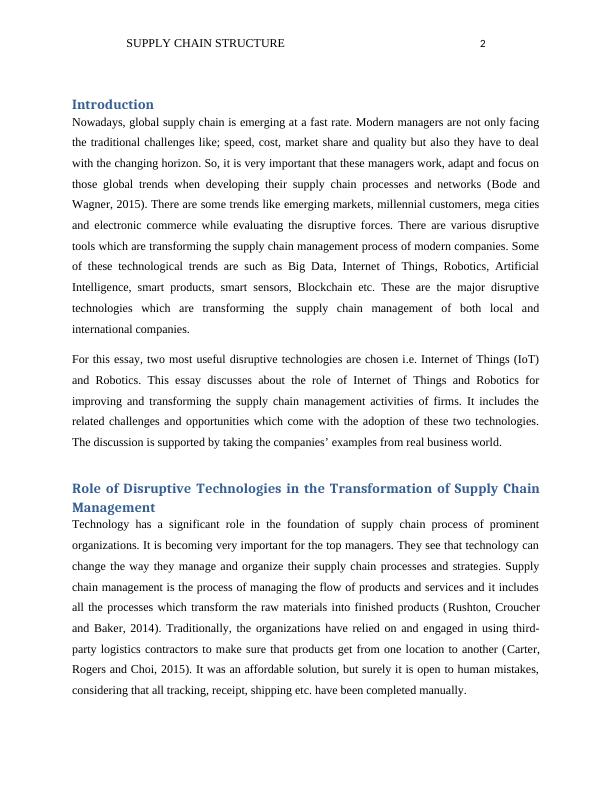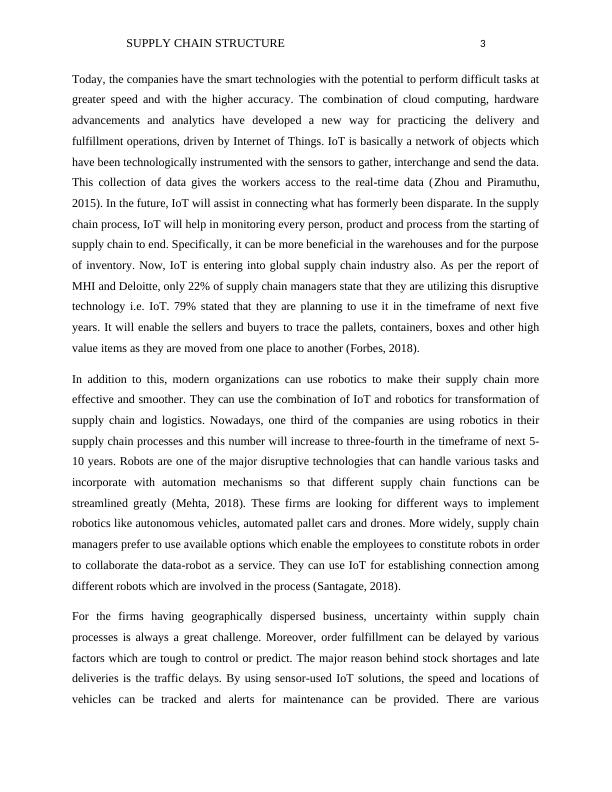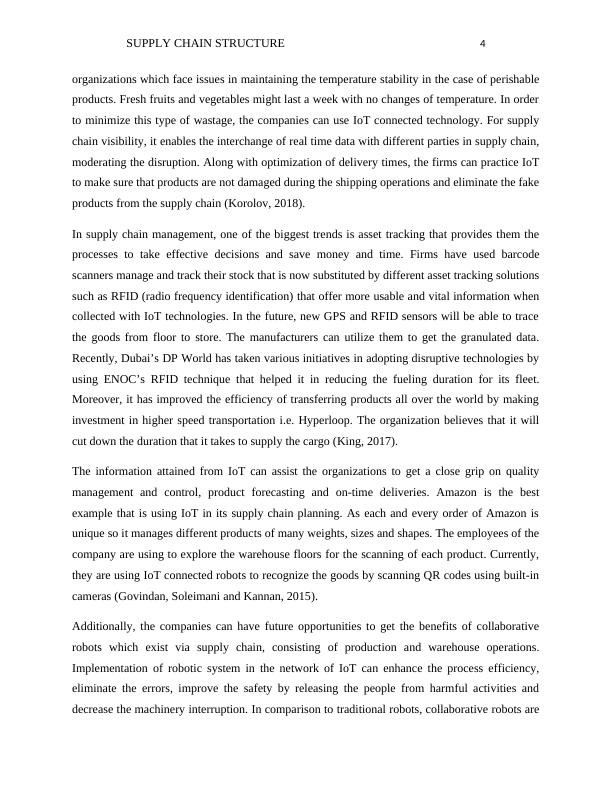Role of Internet of Things and Robotics in Supply Chain Management
11 Pages3661 Words241 Views
Added on 2023-05-30
About This Document
This essay discusses about the role of Internet of Things and Robotics for improving and transforming the supply chain management activities of firms. It includes the related challenges and opportunities which come with the adoption of these two technologies. The discussion is supported by taking the companies’ examples from real business world.
Role of Internet of Things and Robotics in Supply Chain Management
Added on 2023-05-30
ShareRelated Documents
Running Head: SUPPLY CHAIN STRUCTURE 1
SUPPLY CHAIN STRUCTURE
SUPPLY CHAIN STRUCTURE

SUPPLY CHAIN STRUCTURE 2
Introduction
Nowadays, global supply chain is emerging at a fast rate. Modern managers are not only facing
the traditional challenges like; speed, cost, market share and quality but also they have to deal
with the changing horizon. So, it is very important that these managers work, adapt and focus on
those global trends when developing their supply chain processes and networks (Bode and
Wagner, 2015). There are some trends like emerging markets, millennial customers, mega cities
and electronic commerce while evaluating the disruptive forces. There are various disruptive
tools which are transforming the supply chain management process of modern companies. Some
of these technological trends are such as Big Data, Internet of Things, Robotics, Artificial
Intelligence, smart products, smart sensors, Blockchain etc. These are the major disruptive
technologies which are transforming the supply chain management of both local and
international companies.
For this essay, two most useful disruptive technologies are chosen i.e. Internet of Things (IoT)
and Robotics. This essay discusses about the role of Internet of Things and Robotics for
improving and transforming the supply chain management activities of firms. It includes the
related challenges and opportunities which come with the adoption of these two technologies.
The discussion is supported by taking the companies’ examples from real business world.
Role of Disruptive Technologies in the Transformation of Supply Chain
Management
Technology has a significant role in the foundation of supply chain process of prominent
organizations. It is becoming very important for the top managers. They see that technology can
change the way they manage and organize their supply chain processes and strategies. Supply
chain management is the process of managing the flow of products and services and it includes
all the processes which transform the raw materials into finished products (Rushton, Croucher
and Baker, 2014). Traditionally, the organizations have relied on and engaged in using third-
party logistics contractors to make sure that products get from one location to another (Carter,
Rogers and Choi, 2015). It was an affordable solution, but surely it is open to human mistakes,
considering that all tracking, receipt, shipping etc. have been completed manually.
Introduction
Nowadays, global supply chain is emerging at a fast rate. Modern managers are not only facing
the traditional challenges like; speed, cost, market share and quality but also they have to deal
with the changing horizon. So, it is very important that these managers work, adapt and focus on
those global trends when developing their supply chain processes and networks (Bode and
Wagner, 2015). There are some trends like emerging markets, millennial customers, mega cities
and electronic commerce while evaluating the disruptive forces. There are various disruptive
tools which are transforming the supply chain management process of modern companies. Some
of these technological trends are such as Big Data, Internet of Things, Robotics, Artificial
Intelligence, smart products, smart sensors, Blockchain etc. These are the major disruptive
technologies which are transforming the supply chain management of both local and
international companies.
For this essay, two most useful disruptive technologies are chosen i.e. Internet of Things (IoT)
and Robotics. This essay discusses about the role of Internet of Things and Robotics for
improving and transforming the supply chain management activities of firms. It includes the
related challenges and opportunities which come with the adoption of these two technologies.
The discussion is supported by taking the companies’ examples from real business world.
Role of Disruptive Technologies in the Transformation of Supply Chain
Management
Technology has a significant role in the foundation of supply chain process of prominent
organizations. It is becoming very important for the top managers. They see that technology can
change the way they manage and organize their supply chain processes and strategies. Supply
chain management is the process of managing the flow of products and services and it includes
all the processes which transform the raw materials into finished products (Rushton, Croucher
and Baker, 2014). Traditionally, the organizations have relied on and engaged in using third-
party logistics contractors to make sure that products get from one location to another (Carter,
Rogers and Choi, 2015). It was an affordable solution, but surely it is open to human mistakes,
considering that all tracking, receipt, shipping etc. have been completed manually.

SUPPLY CHAIN STRUCTURE 3
Today, the companies have the smart technologies with the potential to perform difficult tasks at
greater speed and with the higher accuracy. The combination of cloud computing, hardware
advancements and analytics have developed a new way for practicing the delivery and
fulfillment operations, driven by Internet of Things. IoT is basically a network of objects which
have been technologically instrumented with the sensors to gather, interchange and send the data.
This collection of data gives the workers access to the real-time data (Zhou and Piramuthu,
2015). In the future, IoT will assist in connecting what has formerly been disparate. In the supply
chain process, IoT will help in monitoring every person, product and process from the starting of
supply chain to end. Specifically, it can be more beneficial in the warehouses and for the purpose
of inventory. Now, IoT is entering into global supply chain industry also. As per the report of
MHI and Deloitte, only 22% of supply chain managers state that they are utilizing this disruptive
technology i.e. IoT. 79% stated that they are planning to use it in the timeframe of next five
years. It will enable the sellers and buyers to trace the pallets, containers, boxes and other high
value items as they are moved from one place to another (Forbes, 2018).
In addition to this, modern organizations can use robotics to make their supply chain more
effective and smoother. They can use the combination of IoT and robotics for transformation of
supply chain and logistics. Nowadays, one third of the companies are using robotics in their
supply chain processes and this number will increase to three-fourth in the timeframe of next 5-
10 years. Robots are one of the major disruptive technologies that can handle various tasks and
incorporate with automation mechanisms so that different supply chain functions can be
streamlined greatly (Mehta, 2018). These firms are looking for different ways to implement
robotics like autonomous vehicles, automated pallet cars and drones. More widely, supply chain
managers prefer to use available options which enable the employees to constitute robots in order
to collaborate the data-robot as a service. They can use IoT for establishing connection among
different robots which are involved in the process (Santagate, 2018).
For the firms having geographically dispersed business, uncertainty within supply chain
processes is always a great challenge. Moreover, order fulfillment can be delayed by various
factors which are tough to control or predict. The major reason behind stock shortages and late
deliveries is the traffic delays. By using sensor-used IoT solutions, the speed and locations of
vehicles can be tracked and alerts for maintenance can be provided. There are various
Today, the companies have the smart technologies with the potential to perform difficult tasks at
greater speed and with the higher accuracy. The combination of cloud computing, hardware
advancements and analytics have developed a new way for practicing the delivery and
fulfillment operations, driven by Internet of Things. IoT is basically a network of objects which
have been technologically instrumented with the sensors to gather, interchange and send the data.
This collection of data gives the workers access to the real-time data (Zhou and Piramuthu,
2015). In the future, IoT will assist in connecting what has formerly been disparate. In the supply
chain process, IoT will help in monitoring every person, product and process from the starting of
supply chain to end. Specifically, it can be more beneficial in the warehouses and for the purpose
of inventory. Now, IoT is entering into global supply chain industry also. As per the report of
MHI and Deloitte, only 22% of supply chain managers state that they are utilizing this disruptive
technology i.e. IoT. 79% stated that they are planning to use it in the timeframe of next five
years. It will enable the sellers and buyers to trace the pallets, containers, boxes and other high
value items as they are moved from one place to another (Forbes, 2018).
In addition to this, modern organizations can use robotics to make their supply chain more
effective and smoother. They can use the combination of IoT and robotics for transformation of
supply chain and logistics. Nowadays, one third of the companies are using robotics in their
supply chain processes and this number will increase to three-fourth in the timeframe of next 5-
10 years. Robots are one of the major disruptive technologies that can handle various tasks and
incorporate with automation mechanisms so that different supply chain functions can be
streamlined greatly (Mehta, 2018). These firms are looking for different ways to implement
robotics like autonomous vehicles, automated pallet cars and drones. More widely, supply chain
managers prefer to use available options which enable the employees to constitute robots in order
to collaborate the data-robot as a service. They can use IoT for establishing connection among
different robots which are involved in the process (Santagate, 2018).
For the firms having geographically dispersed business, uncertainty within supply chain
processes is always a great challenge. Moreover, order fulfillment can be delayed by various
factors which are tough to control or predict. The major reason behind stock shortages and late
deliveries is the traffic delays. By using sensor-used IoT solutions, the speed and locations of
vehicles can be tracked and alerts for maintenance can be provided. There are various

SUPPLY CHAIN STRUCTURE 4
organizations which face issues in maintaining the temperature stability in the case of perishable
products. Fresh fruits and vegetables might last a week with no changes of temperature. In order
to minimize this type of wastage, the companies can use IoT connected technology. For supply
chain visibility, it enables the interchange of real time data with different parties in supply chain,
moderating the disruption. Along with optimization of delivery times, the firms can practice IoT
to make sure that products are not damaged during the shipping operations and eliminate the fake
products from the supply chain (Korolov, 2018).
In supply chain management, one of the biggest trends is asset tracking that provides them the
processes to take effective decisions and save money and time. Firms have used barcode
scanners manage and track their stock that is now substituted by different asset tracking solutions
such as RFID (radio frequency identification) that offer more usable and vital information when
collected with IoT technologies. In the future, new GPS and RFID sensors will be able to trace
the goods from floor to store. The manufacturers can utilize them to get the granulated data.
Recently, Dubai’s DP World has taken various initiatives in adopting disruptive technologies by
using ENOC’s RFID technique that helped it in reducing the fueling duration for its fleet.
Moreover, it has improved the efficiency of transferring products all over the world by making
investment in higher speed transportation i.e. Hyperloop. The organization believes that it will
cut down the duration that it takes to supply the cargo (King, 2017).
The information attained from IoT can assist the organizations to get a close grip on quality
management and control, product forecasting and on-time deliveries. Amazon is the best
example that is using IoT in its supply chain planning. As each and every order of Amazon is
unique so it manages different products of many weights, sizes and shapes. The employees of the
company are using to explore the warehouse floors for the scanning of each product. Currently,
they are using IoT connected robots to recognize the goods by scanning QR codes using built-in
cameras (Govindan, Soleimani and Kannan, 2015).
Additionally, the companies can have future opportunities to get the benefits of collaborative
robots which exist via supply chain, consisting of production and warehouse operations.
Implementation of robotic system in the network of IoT can enhance the process efficiency,
eliminate the errors, improve the safety by releasing the people from harmful activities and
decrease the machinery interruption. In comparison to traditional robots, collaborative robots are
organizations which face issues in maintaining the temperature stability in the case of perishable
products. Fresh fruits and vegetables might last a week with no changes of temperature. In order
to minimize this type of wastage, the companies can use IoT connected technology. For supply
chain visibility, it enables the interchange of real time data with different parties in supply chain,
moderating the disruption. Along with optimization of delivery times, the firms can practice IoT
to make sure that products are not damaged during the shipping operations and eliminate the fake
products from the supply chain (Korolov, 2018).
In supply chain management, one of the biggest trends is asset tracking that provides them the
processes to take effective decisions and save money and time. Firms have used barcode
scanners manage and track their stock that is now substituted by different asset tracking solutions
such as RFID (radio frequency identification) that offer more usable and vital information when
collected with IoT technologies. In the future, new GPS and RFID sensors will be able to trace
the goods from floor to store. The manufacturers can utilize them to get the granulated data.
Recently, Dubai’s DP World has taken various initiatives in adopting disruptive technologies by
using ENOC’s RFID technique that helped it in reducing the fueling duration for its fleet.
Moreover, it has improved the efficiency of transferring products all over the world by making
investment in higher speed transportation i.e. Hyperloop. The organization believes that it will
cut down the duration that it takes to supply the cargo (King, 2017).
The information attained from IoT can assist the organizations to get a close grip on quality
management and control, product forecasting and on-time deliveries. Amazon is the best
example that is using IoT in its supply chain planning. As each and every order of Amazon is
unique so it manages different products of many weights, sizes and shapes. The employees of the
company are using to explore the warehouse floors for the scanning of each product. Currently,
they are using IoT connected robots to recognize the goods by scanning QR codes using built-in
cameras (Govindan, Soleimani and Kannan, 2015).
Additionally, the companies can have future opportunities to get the benefits of collaborative
robots which exist via supply chain, consisting of production and warehouse operations.
Implementation of robotic system in the network of IoT can enhance the process efficiency,
eliminate the errors, improve the safety by releasing the people from harmful activities and
decrease the machinery interruption. In comparison to traditional robots, collaborative robots are

End of preview
Want to access all the pages? Upload your documents or become a member.
Related Documents
Internet of Things in Smart Farming: A Literature Reviewlg...
|10
|2449
|288
Internet of Things Integration with Enterprise Systemslg...
|11
|768
|258
Managing Organizations and Leading Peoplelg...
|8
|1500
|34
ENTERPRISE INTERNET OF THINGS.lg...
|10
|388
|61
The Internet of Things (IoT) and Smart-citieslg...
|16
|4338
|316
Entrepreneurship for Hospitality Leaderslg...
|16
|3052
|41
